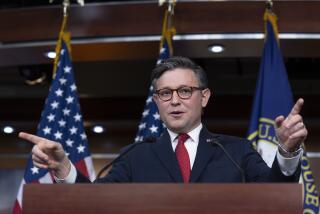A government shutdown could hurt economy more now than it did in 1995
WASHINGTON — The last time the federal government shut down, for three weeks in the winter of 1995-96, the American economy felt a jolt but recovered quickly.
Things don’t look anywhere near as promising this time around.
The nation is currently more than four years into an economic expansion with some momentum behind it. That also was the case in 1995. But this time, things are a lot more fragile.
Shutdown Q&A: How long? What’s the impact?
Americans continue to suffer from a relatively high unemployment rate of 7.3%, which is about 2 percentage points higher than in December 1995. Back then, job growth was stronger, the economy was starting to benefit from the tech boom, and baby boomers were entering their prime earning years, not preparing for retirement.
The recovery from the Great Recession has been sluggish and repeatedly held back by political budget battles, but many had been hoping the economy would pick up steam heading into next year. Housing and stock markets have been growing, and consumers have cut their debts and are feeling more confident.
“Even in the best-case scenario,” said Dean Baker, co-director of the Center for Economic and Policy Research in Washington, “it’s going to slow things down.”
Estimates of economic effect vary.
However, most analysts predict that a two-week partial government shutdown would shave 0.3 to 0.4 of a percentage point from economic growth in the fourth quarter. Much of this would be due to lost pay for hundreds of thousands of furloughed federal workers.
Although not devastating, that’s not a small amount either, especially for an economy that has been growing this year at an anemic annual rate of less than 2%.
A longer downtime would result in increasingly larger and escalating problems for the economy. It would cause disruptions in private-sector production and investments, as well as greater volatility in financial markets.
During the 21-day shutdown from mid-December 1995 to early January 1996, stocks lost about 4% of their value, according to Sam Stovall, chief equity strategist for S&P Capital IQ. But after President Clinton and Congress reached an agreement and government offices reopened, stocks took off, shooting up more than 10% in the following month.
Data show that job growth also quickly bounced back after stalling that December. And economic growth soared to more than 7% annualized in the second quarter of 1996 after weakening to 2.7% in the first quarter.
That sharp rebound was helped by back-to-back rate cuts by the Fed. But today the central bank’s benchmark rate is already near zero, and its unconventional stimulus — buying $85 billion of bonds every month — is seen by many people as enough.
The Fed has been contemplating trimming the stimulus, but it held back from doing so in September partly because of the budget impasse and its threatening effects.
Also, this time, it’s unclear whether federal workers considered to be in nonessential jobs and facing furloughs would be able to recoup their pay, as they did in 1996. The current political environment suggests this would be hotly contested.
“In the past, Congress has always paid furloughed workers when the budget agreement is achieved, but there is no guarantee,” said Daniel Meckstroth, an economist for the manufacturers group known as MAPI. “Tea party hard-liners will likely put up stiff resistance to any agreement that remunerates federal employees for the time they did not work.”
Some of MAPI’s member companies fear that federal contractor payments will be delayed. Based on the experience of 1995-96, a wide variety of businesses, local governments and ordinary citizens across the country could expect to feel a pinch from closures or disruptions at national parks, ports, passport offices and other public services.
If a shutdown were to last more than a short period, Ebony Brown figures she would have to look for another job. Brown works in the cafeteria at the National Museum of Natural History in Washington, which like many other government operations contracts out food services.
“You’ve got to pay bills,” she said Monday, unsure whether she would report to work Tuesday.
State governors worry that the budget fallout in Washington would trickle down to them, setting back the progress made during the tough recovery when they slashed spending and overhauled programs.
“A lack of certainty at the federal level from a shutdown … translates directly into uncertainty and instability at the state level,” the National Governors Assn. said in a letter to congressional leaders. “That uncertainty can lead to the suspension of programs and services, increased borrowing costs or even layoffs.”
Although difficult to measure, most analysts agree that the longer the shutdown, the higher the uncertainty. And that could mean a greater cost to the economy.
Surveys show consumer sentiment weakened in September, with some expressing concerns about the budget situation. The drop, though, was much less than the plunge in confidence during the summer of 2011 when a protracted fight over the debt ceiling threatened to cause a default, led to a downgrading of the U.S. credit rating and weakened momentum in the recovery.
By economist Mark Zandi’s estimations, the high levels of uncertainty during the recovery have cost the American economy $150 billion in activity and up to 1 million jobs.
“With each passing day [of a shutdown], investors are going to grow more nervous,” said Zandi, of Moody’s Analytics. “It’ll show up in lower stock prices, which we’re already seeing, higher interest rates for mortgages and business loans and an eroding confidence among businesses and consumers who will pull back on spending and investments.”
For now, many are grappling with more immediate concerns of a partially disabled government — and how businesses and investors would react to that.
On Friday, the Labor Department is scheduled to release its monthly jobs report. Many analysts think the job gains for September may show a welcome improvement from the recent slowdown. But in the event of a federal government shutdown, Labor Department officials indicated that the report could be delayed.
“All survey and other program operations will cease and the public website will not be updated,” Erica L. Groshen, commissioner of the Bureau of Labor Statistics, said in a Sept. 10 memo, although it is possible that the jobs report could still be released as planned if it receives a special exemption.
But the government issues many economic reports every week, and uncertainty hanging over them would make it harder for people to gauge how the economy is performing. And that could affect hiring and other decisions.
“They’re certainly going to be reluctant to undertake investments if they don’t have a clue what’s going on in the economy,” said Baker, the Washington economist.
Staff writers Andrew Tangel in New York and Jim Puzzanghera and Becca Clemons in Washington contributed to this report.







